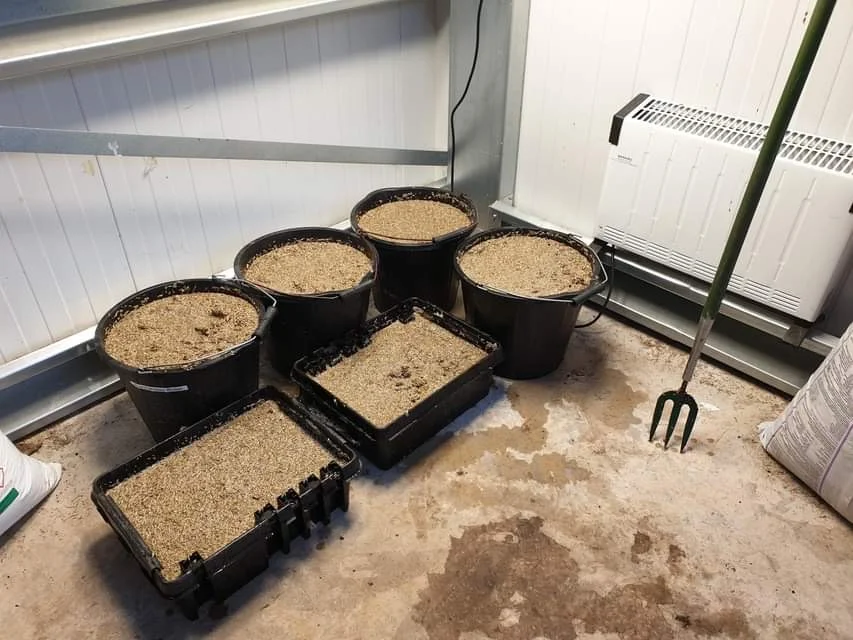Here Is the Best Way to Sharpen Lawn Mower Blades
Last Updated on January 14, 2025 by Duncan
For you to effectively cut the grass on your lawn, you need to have sharp lawn mower blades.
If this is the first time you are sharpening them, you must be wondering what is the best way to sharpen lawn mower blades, right? Well, there are plenty of ways to go about it. These ways include:
Using a file to sharpen lawn mower blades
A file is one of the simplest and inexpensive tools you can use to sharpen your lawn mower blades.
When getting the files, some of the best ones to go for are: 10- to 12-inch mill, flat, and hand files with a coarse cutting profile known as “bastard cut.” These file types have different thickness and width tapers.
There is none that is better than the other. It’s all about your personal preferences.
When sharpening your blades with a file, place the blade in a vise or securely clamp it to a sturdy workbench. Before you begin, use a wire brush to remove any old grass clippings, dirt, or surface rust.
Examine the present blade angle, which the manufacturer previously sharpened. You’ll want to match that angle with the file, so position the blade as conveniently as possible.
The file will only cut when you push it away from you. Begin with the forward end of the file near the base of the mower blade’s cutting edge, and firmly push it away from you and along the edge.
You will need to apply some pressure, but you should have some balance between pressing it and allowing the file to do the work.
Keep track of how many strokes it takes you to repair and match the edge on the opposite side.
While you can use a file to sharpen any lawn mower blades, you should consider replacing the blades if there are large nicks or the blade is severely deteriorated.
Sharpening the lawn mower blade using a bench grinder
When using the bench grinder, you need to hold the lawn mower blade in your hands while sharpening it. A bench grinder emits sparks, so always wear eye protection when sharpening
Even though the metal blade will grow warm, it is recommended to avoid using gloves. This is because the grinding wheel could catch the glove, causing bodily harm. Second, you do not want the blade to become so heated that it loses its toughness.
After fitting the bench grinder with a suitable grinding wheel and properly fixing the tool rest, place the lawn mower blade on the grinding wheel with the cutting edge facing up.
Move the blade so that the cutting edge moves smoothly past the grinding wheel, being careful not to overheat the metal.
If the metal edge begins to darken or change color, it is becoming hot, and you must move quickly.
Sharpening the lawn mower blade using a Dremel grinder
While a Dremel rotary tool isn’t always the ideal option for sharpening lawn mower blades, their popularity warrants mention here.
Similar to other approaches, matching the existing blade angles and keeping the blade balanced are critical considerations.
Dremel’s “Lawn Mower Sharpening Attachment” makes sharpening lawn mower blades easier than using files or angle grinders.
Dremel advertises its specialist tool as “the fastest, easiest way to sharpen lawnmower blades.”
While the attachment will help maintain a normal set angle, it may not correspond to the angle of your lawn mower blades.
If it does not match, you will have to manually modify or change the angle of your blade, which may necessitate extensive labor with a Dremel.
Maintaining smooth strokes is essential whether or not you use the Dremel lawn mower blade attachment.
Avoid using rapid motions to sharpen lawn mower blades, as this may result in a wavy blade edge that does not operate as intended.
Sharpening the lawn mower blades using a dedicated mower blade sharpener
If you are a heavy user of your lawn mower and you have to sharpen many lawn mower blades a year, it may be wise to invest in a dedicated sharpener.
Some of these devices mount on your workbench and require an angle grinder. Others offer a complete solution for sharpening lawn mower blades.
Expect to spend a couple of a hundred dollars on a piece of decent equipment. While that may seem like a lot, the ease and convenience of using a dedicated machine and precisely sharpening your lawn mower blades at home quickly pays for itself.
Maintaining blade balance is crucial for any equipment you use to sharpen your lawn mower blades.
Remember that unbalanced blades cause excessive vibration, which may harm your mower’s bearings and seals, limiting its life. You don’t want this, do you?
The cool thing is that there are plenty of precision blade balancers that you can use to determine whether your lawn mower blade is balanced.
Another simple method you can use is to insert a small nail into a vertical surface, such as a wall or the side of a workbench, then hang the blade by the center hole horizontally. If the blade is not balanced, don’t use it.
Can you sharpen mower blades without removing them?
From the above ways of sharpening a lawn mower blade, you might have noticed that you have to remove the blade from the lawn mower to sharpen it. What if you don’t want to remove the blade? Can you sharpen it? The good news is that you can do it.
While it’s not the most ideal or best way to do it, you can definitely sharpen your lawn mower blades without removing them.
How do you sharpen a lawn mower blade without removing the blade?
Well, to do so, you need to follow these steps:
Step 1: Prepare for the sharpening
Start by gathering the tools you need for the sharpening. You will need a grinder or file, and gloves, safety glasses, or goggles.
You’ll also need an extra 4×4 block of wood (12″ to 18″), steel wool, and a wire brush.
Besides gathering the right tools, you need to disconnect the lawn mower from all available power sources to avoid inadvertent starting or turning while working.
This calls for you to ensure that the spark plug cable is unplugged from the spark plug or unhook the power cord.
You also need to place the lawn mower on its side, with the carburetor pointing upwards. Additionally, add a block below the engine or motor to improve stability.
Step 2: Clean the blade
You need to clean the blade attentively to get rid of rust, caked grass, and other debris. After cleaning the blade, you will have complete access to your blade’s cutting edges.
When doing the cleaning, use soapy water and a rag. You can also use a steel wire brush to remove stuck-on-grime.
Just make sure you are extra cautious throughout this process. Blades might be dull, but that doesn’t mean they’re not sharp. So take care that you don’t get cut.
Step 3: Sharpen the blades slowly
Begin grinding with a grinder or sharpener. When sharpening, keep your handheld or electric grinder at an angle while working.
You should work slowly, beginning with one side of the blade and on to the other. Move the grinder in a single direction and only sharpen the blade’s upper face.
You don’t want to travel back and forth like a sawing action; instead, use smooth strokes across the surface.
Valuable tips to follow when sharpening lawn mower blades
Only sharpen the mower’s blades with an empty gas tank: When you are looking to sharpen lawn mower blades without removing them, to avoid fuel loss, make sure the gas tank is empty before starting to sharpen the blades.
Know when the blades are dull and require sharpening: To determine if your blades are dull, inspect the grass blades on your line for evidence of tearing and splitting at the tips.
Know when the blades should be replaced: If the mower blade is out of balance, bent, nicked all over, or the driveshaft hole is entirely ruined, you should replace it.
This is because the blades are irreparably damaged, rendering them ineffective for cutting your grass.
Address the nicked blades issue: Nicked blades do not necessarily imply that your lawn mower blades have been destroyed.
This is far from the case, as nicked blades may also be sharpened; however, using a bench grinder is recommended for the best results.
Confirm that the blades are balanced correctly. The blades must be well-balanced; otherwise, strange noises will emerge from beneath the lawn mower’s deck.
One of the reasons for an imbalanced blade is a wallowed-out driveshaft hole and a dull blade.
Parting shot
These are some of the best ways to sharpen lawn mower blades. As you have seen, you can sharpen the blades with the blades still in place or you can remove them.
Regardless of how you do it, ensure that you use the right tools. You also should ensure that you inspect the blades and confirm that they are worth sharpening. If they are too worn out, it will be better to replace them.


